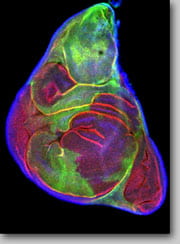The Fehon Lab
Cellular organization and function of the Hippo Pathway in tissue growth controlOur research
The precise coordination of proliferation, apoptosis and nutrient acquisition is a key feature of growth regulation in developing tissues. Studies in recent years, primarily using the powerful genetic, molecular and cellular tools available in Drosophila, have identified the Hippo pathway as an important regulator of tissue growth. While we know the basic components of this signal transduction pathway, little is known about how the subcellular localization, compartmentalization, and molecular interactions between pathway proteins are regulated to control Hippo signaling in developing tissues. Indeed, a critical gap in our understanding of Hippo pathway function is elucidating the molecular mechanisms that link the upstream components Merlin, Expanded and Kibra, which are localized to the cell cortex, to activation of the core kinases, Tao-1, Hippo and Warts. Additionally, while it is known that mechanical tension can promote tissue growth by inactivating Hippo signaling, it is not known whether tension operates in concert with, or in parallel to other upstream mechanisms. Elucidating how Merlin, Expanded and Kibra regulate Hippo pathway activity in living tissues is critical to understanding how growth is regulated in normal development and how abnormal growth can occur in diseases such as cancer.
Our research focuses on understanding how upstream components function to regulate the Hippo growth control pathway. This work currently has three primary foci. First, our recent work has shown that upstream pathway regulation is divided into two parallel mechanisms that localize to separate subcellular compartments. Currently we are working to understand how the activity of these parallel upstream inputs is regulated, how their component proteins cooperate to assemble functional signaling complexes and why the cell needs these two parallel inputs. In a second line of research recently we have discovered that Yorkie, the transcriptional coactivator that mediates the pathway’s transcriptional output, also functions at the cell cortex to activate myosin contractility. We believe this non-transcriptional function of Yorkie serves to amplify the effects of mechanical tension on Yorkie activity. Third, we studying the functions of a myosin-like protein Dachs that represses pathway activity and thereby promotes tissue growth. Currently we are working to understand how Dachs functions at the cell cortex and how two protocadherins, Fat and Dachsous, function together to regulate the activity of Dachs.
